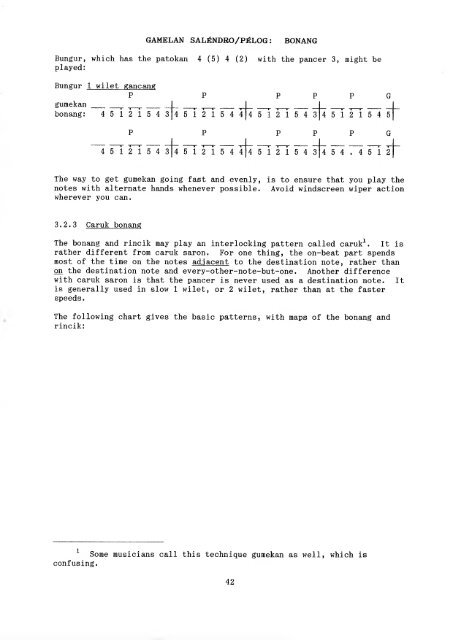Guide to Sundanese Music - Free EBooks Library
Guide to Sundanese Music - Free EBooks Library
Guide to Sundanese Music - Free EBooks Library
You also want an ePaper? Increase the reach of your titles
YUMPU automatically turns print PDFs into web optimized ePapers that Google loves.
GAMELAN SALfiNDRO/PfiLOG : BONANG<br />
Bungur, which has the pa<strong>to</strong>kan 4 (5) 4 (2) with the pancer 3, might be<br />
played:<br />
Bungur 1 wilet gancang<br />
P<br />
gumekan<br />
bonang: 45121543<br />
P<br />
4 5 12 15 4 3<br />
—r- -1 r<br />
4 5 12 15 4 4<br />
P<br />
—r -I r-<br />
45121544<br />
4 5 12 15 4 3<br />
P P<br />
G<br />
—r T r-<br />
4 5 12 15 4 5<br />
P G<br />
~r -» r<br />
4 5 12 15 4 3 4 5 4.4512<br />
The way <strong>to</strong> get gumekan going fast and evenly, is <strong>to</strong> ensure that you play the<br />
notes with alternate hands whenever possible. Avoid windscreen wiper action<br />
wherever you can.<br />
3-2.3 Caruk bonang<br />
The bonang and rincik may play an interlocking pattern called caruk^. It is<br />
rather different from caruk saron. For one thing, the on-beat part spends<br />
most of the time on the notes adjacent <strong>to</strong> the destination note, rather than<br />
on the destination note and every-other-note-but-one. Another difference<br />
with caruk saron is that the pancer is never used as a destination note. It<br />
is generally used in slow 1 wilet, or 2 wilet, rather than at the faster<br />
speeds.<br />
The following chart gives the basic patterns, with maps of the bonang and<br />
rincik:<br />
Some musicians call this technique gumekan as well, which is<br />
confusing.<br />
42








